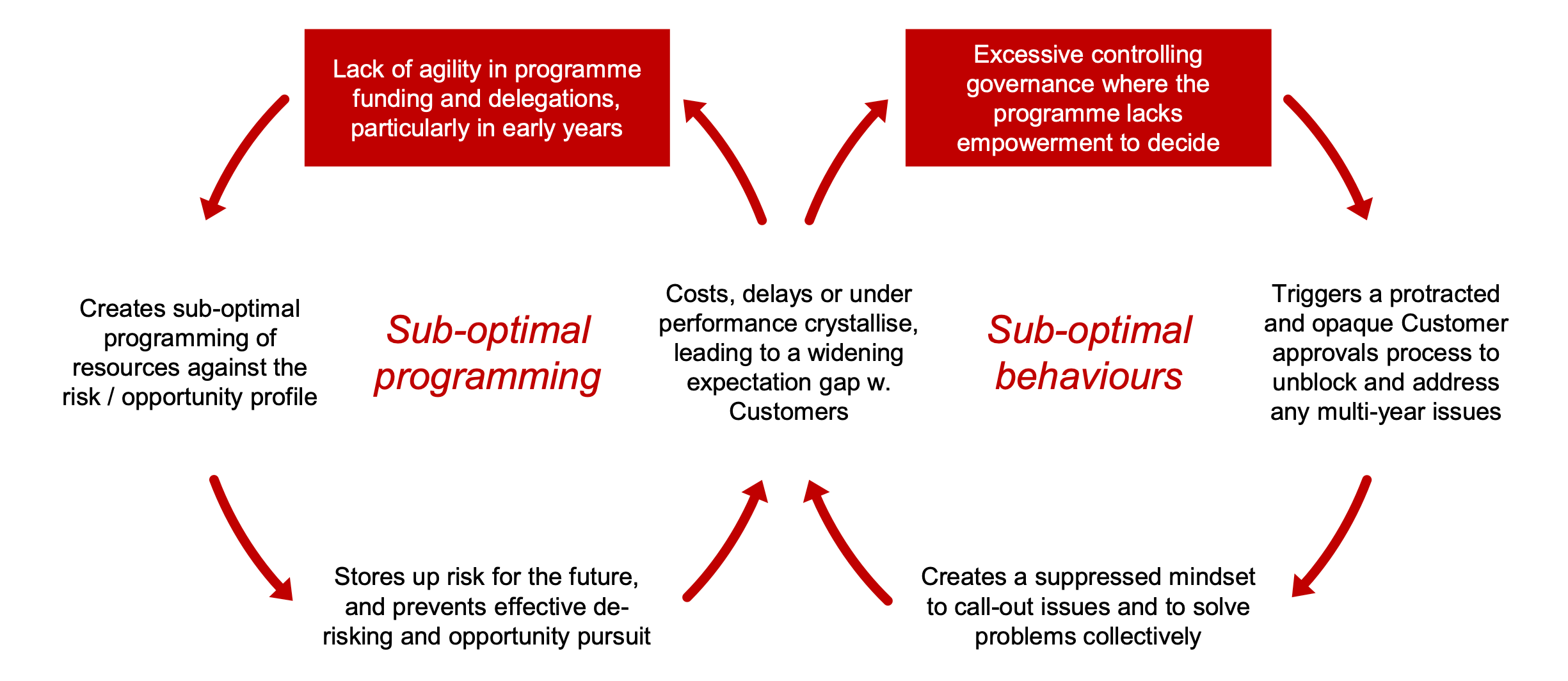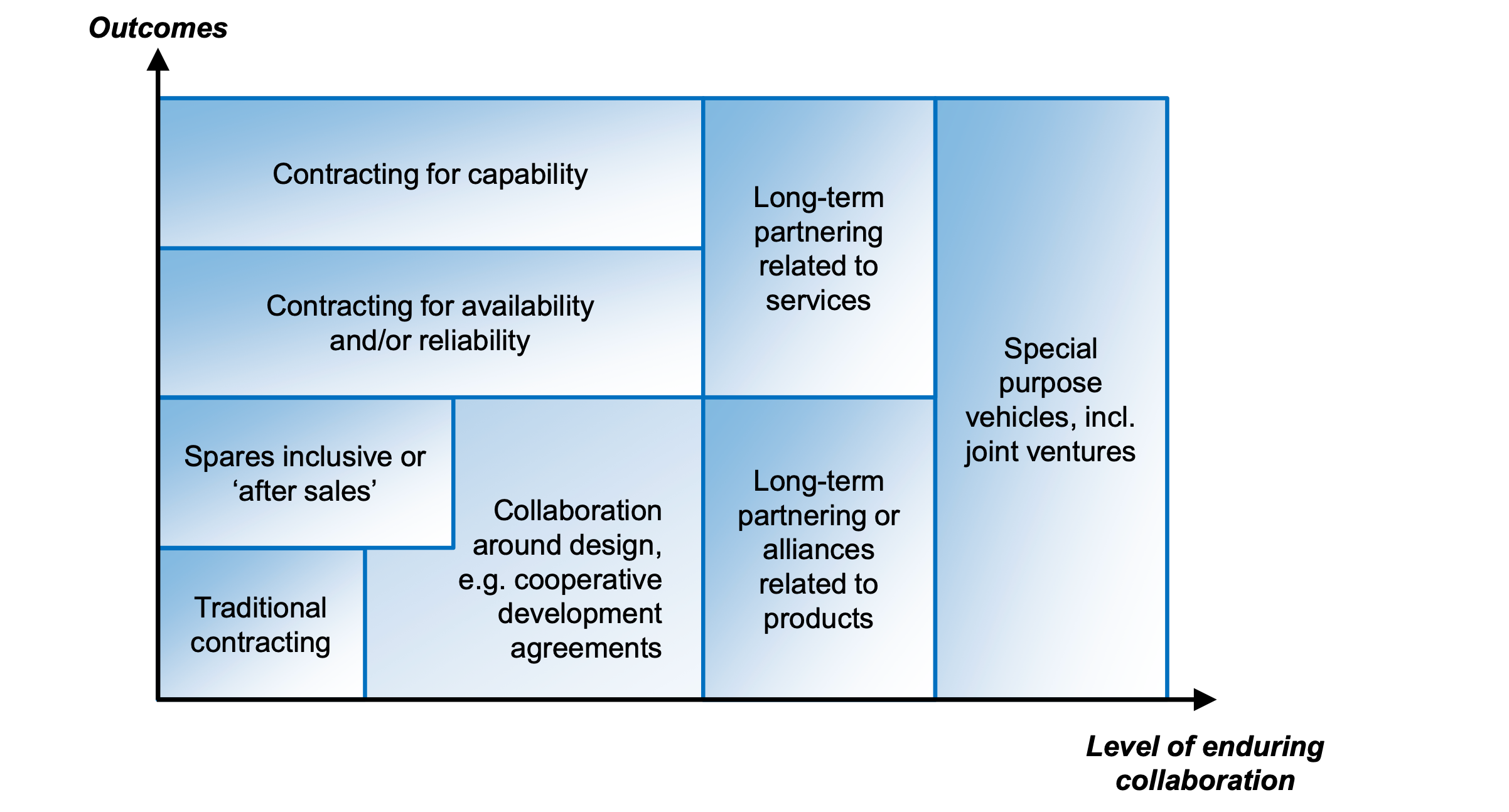Agile Acquisition & Rapid Delivery in Defence – Partnering for Success
- News Article
- Joint
- Future tech

 The old adage goes: “plan for failure, but hope for success.” Yet, defence programmes are much too important and complex for static plans prosecuted through hopes and wishes. Defence programmes need to be relentless and active as they scan for failure, and partner for success.
The old adage goes: “plan for failure, but hope for success.” Yet, defence programmes are much too important and complex for static plans prosecuted through hopes and wishes. Defence programmes need to be relentless and active as they scan for failure, and partner for success.
In the last article we introduced VUCA as the context in which major defence programme operate. As a response, here we elaborate on why and how these programmes should ‘partner for success’.
Walking the path to success
The challenge in major defence programmes is an inability to see, and then walk, the path to success. The task of Senior Responsible Owners (SROs) in acquiring new equipment and delivering quickly in the most complex programmes is challenging.
This is due to:
- The prevalence of VUCA. In the last article, we explored VUCA – volatility, uncertainty, complexity and ambiguity. Those factors act on major defence programmes in a way that makes single plans, and fixed structures quickly redundant. VUCA blurs the path SROs need to walk their programmes to success due to risks associated with novelty in new kit or tech, lack of precedent in blending capabilities, limited information or fragile supplier markets.
- The natural limits on leadership tenure. Outcomes are often decades out. Dreadnought took a decade in design, will take two decades in build and many decades in service. Granted submarines are an extreme example, but on average the tenure of defence SROs is 20 months, a span considerably shorter than the median programme length of 77 months.[1] The leadership may need to stay longer, but it is the reality that capable leaders change roles over time and move on. The programme outlasts any given set of leadership – put the other way, any given leader acts as a steward for their successors inside a programme they caretake for a time.
- The need to resolve multiple interests. These programmes by their nature, have many parties holding a stake, each with demands, competing interests and divergent perceptions. This includes Tier 1 industry, government procurement, the Commands that hold budgets, the User that tests, commissions and takes the capability. Additionally, finance ministries that tie up significant sums of taxpayer funds over multiple generations, and broader interests have a stake. Thus, programmes need the architecture to coalesce stakeholder interests without getting bogged down in layers of debilitating governance.
Those features make outcomes hard to deliver and they are not transitory. Rather, they are the ‘systemic’ challenges of major defence programmes, the conditions in which they operate.
Systemic challenges require systemic solutions.
The art of agile acquisition and rapid delivery rests on collaboration because there are too many trades to make and too many dependencies to honour in pushing major defence programmes forward.
Traditional, bilateral contracting arrangements do not handle well the system-problem associated with VUCA. In complex programmes, VUCA creates sub-optimal programming and behaviours.
See Figure 1. These ‘doom loops’ are what partnering seeks to resolve.

Source: Deloitte analysis, 2023
The assertion of this article is that Defence needs to enter a new age of partnering. This is not the case everywhere. However, in the most critical, complex programmes, speed and agility happen when government and industry come together.
And we see this happening, for example: alliancing in Dreadnought, joint ventures in Tempest, new commercial arrangements in military satellites. Beyond defence, there are of course, alliancing arrangements in transport on the Trans-Pennine Route Upgrade, and government-owned companies in High Speed 2 and Crossrail.
These forms of partnering are not new. However, they are being driven by different factors than they once were, notably in the 1990s. At that time, international defence saw an overly large industrial base. That provoked a consolidation of the defence market – a set of dialogue in the US dubbed the ‘Last Supper’ as Pentagon officials informed industry of budget cuts. In the UK, the 2005 Defence Industrial Strategy triggered as series of partnering between government and industry as a down-sized industry needed reassurance on demand through long-term supply agreements. This created exclusivity agreements in munitions, complex weapons, long-range testing and evaluation, shipbuilding, submarine support and helicopters.
Today, the conditions are very different, but the age of government and industry partnering is back. Demand in Defence is high due to the need to respond to those issues flagged in the recent Defence Command Paper: Defence’s response to a more contested and volatile world. Programmes are increasingly internationalised to treat issues of affordability and geopolitical interest, e.g. AUKUS, Tempest / Global Combat Air, Naval support under NSIGN. There is a premium on innovation and digitalisation in both government and industry through Industry 4.0 type initiatives, and there are major ‘commons’ issues related to energy transition that will require partnering and co-investment approaches both within and beyond Defence.
So, all those points made earlier around VUCA, leadership tenure and multiple interests are that much more acute because programmes are more complex.
Partnering models – when done well – create the mutual commitments between governments and industries that can enable major programme success:
- Those commitment can deal with VUCA because they manifest as investment in, for example, contingency funds, new methods, innovations, the best personnel each party has to offer.
- Those commitments create an environment in which long-term cultures are shaped. Those cultures are nurtured by successive leaders over a programme’s life, but outlast any given SRO. The partnering arrangement is a thing beyond any particular leader.
- Those commitments in their making set the rules that govern how multiple interests will be resolved and how collaboration happens.
In Dreadnought, partnering under an alliance between MOD and Industry creates the collaboration that allows hundreds of decisions made daily that keep a focus on the schedule – ‘every day counts’, whilst recognising the schedule continues to be a challenge.
In Complex Weapons, MOD’s partnership with Industry over a decade and more has sought Defence to ‘buy portfolios, not individual products’. In so doing, they have been able to invest in commonality, modularity and reuse efficiencies between weapon types. Modularity allows complex endeavours to be broken down into smaller, manageable and de-risked initiatives, as well as improving the return on investment for industry – ‘make once, use many’.
In Tempest / Global Combat Air Programme, multiple commercial constructs are needed to manage an international programme between three nations – the UK, Italy and Japan – that brings the best of their respective capabilities. Indeed, “the new AUKUS and GCAP partnerships exemplify our commitment to deepening the relationships between the Euro-Atlantic and Indo-Pacific regions, and to facing the threats of the future together.” (Defence Command Paper, 2023)
At Deloitte, we have had the privilege of supporting both government and industry architect these new ways of partnering for the long-term. We recognise that within the concept there is a range of different variants. These are presented conceptually in Figure 2.
Figure 2 – contracting and partnering for success

Source: Deloitte analysis, 2023
Each programme needs to consider what contracting and programme architecture suits itself best. This is driven by the VUCA features of that programme and how value is created. For example, programmes facing significant supply-side constraints, e.g. new skills and investments in disruptive technology, are not best served through traditional contracting or outsourcing because the market from which government seeks to source that capability is itself thin or immature. That approach designs for disappointment.
Rather, those conditions provoke a case for co-investment – to build the supply-side. That can only be achieved within a programme architecture that creates mutual commitment; whereby government provides assurances, visibility of demand, or anchor investment that is sufficient (and only just sufficient) for private investors and industry to take on their own portion of the risk and to drive scale and reach.
At Deloitte, we have a heritage of supporting this type of programme deal-making in Defence – bringing together strategy, operations, corporate finance and transaction expertise, as well as programme delivery encapsulated in our Programme Aerodynamics® approach.
[1] MoD project leads often without project management experience (ukdefencejournal.org.uk)
Secured your ticket for DSEI?
AUTHOR DETAILS:

Priyen Patel - Partner priypatel@deloitte.co.uk
Dominic Cook - Partner dccook@deloitte.co.uk
© 2023 Deloitte LLP. All Rights Reserved. The contents of this article are confidential and the intellectual property of Deloitte LLP and may not be reproduced, redistributed or passed on to any other person in whole or in part without the prior written consent of Deloitte.
This publication contains general information only, and none of the Deloitte member firms are by means of this publication, rendering professional advice or services. Before making any decision or taking any action that may affect your business, you should consult a qualified professional adviser.
-
DSEI 2023: Royal Navy To Set Up In Receive Mode, To Support Partnering Against Future Threats
04 Sep 2023 Dr Lee WillettThe UK Royal Navy (RN) will have significant presence at the DSEI 2023 exhibition, which is taking place at ExCeL London on 12-15 September. It is also seeking to grasp the engagement opportunity that ... -
Agile Acquisition & Rapid Delivery in Defence – Resilient Teams Harnessing Digital Means
04 Sep 2023“Technology is an extension of human behaviour” – a quote attributed variously, but traceable to the Canadian philosopher, Herbert Marshall McLuhan. Whilst originally referencing the study of media, t ... -
“Nobody ever stops or intervenes in a poor project soon enough. The temptation is always to ignore or under-report warning signs and give more time for things to improve to avoid revealing bad news, r ...
-
Agile Acquisition & Rapid Delivery in Defence – Dealing with VUCA
25 Aug 2023 Priyen Patel & Dominic Cook | Deloitte“We have gone from a competitive age to a contested and volatile world. Since March 2021, the threats and challenges we faced have manifested themselves, as have many of the technological advances pre ... -
Commercial Success in Remedying MOD Legacy IT
25 Aug 2023The great militaries of the future are those with resilient, future-ready digital foundations and who are pulling away from the rest; while those that lack digital transformation expertise and rely ... -
Defence organisations are being challenged to upskill and reskill against a backdrop of talent scarcity and changing worker expectations. Shifting towards a skills-based workforce approach provides a ...

)
)
)
)
)
)

